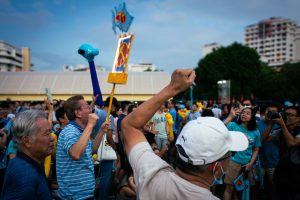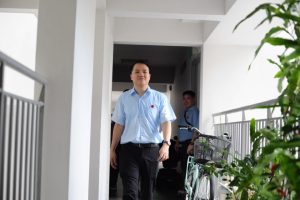All images by Stephanie Lee for RICE Media unless otherwise stated
The landslide win of President-elect Tharman Shanmugaratnam in the presidential elections has been dissected many times over.
Some analysts credit his pineapple logo and ‘ong lai’ chant for contributing to his landslide win. Others cite the enigmatic ‘Tharman effect’.
ADVERTISEMENT
In any case, Mr Tharman’s victory came as no surprise. Perhaps the more shocking thing was his overwhelming 70.4 percent vote share on Polling Day. That, plus the 76.16 percent vote share he got from overseas voters.
The large margin indicated that even opposition supporters voted for him. His decisive victory over Ng Kok Song and Tan Kin Lian is also a good sign that Singaporeans are more than ready for a non-Chinese leader.
Had voting gone purely along racial lines, he might have seen a vote share of nine percent from the Indian population or 25.7 percent from racial minorities in Singapore. That obviously wasn’t the case. Mr Tharman’s vote share was evidence that he’d won the hearts of a large swathe of Singapore’s population, a majority of which belonged to a different race than his.
As Mr Tharman himself mentioned in the run-up to the election, voters “look at people in totality”. And he was right.
His flawless track record and gravitas cemented him as the obvious choice for many. His ethnicity was hardly part of the conversation in the lead-up to polling day.
In the days since his victory, though, there has been some talk about what this election showing means for the future of another important role in Singapore’s administration: the PM.
Ability Trumps Race
A YouGov survey released this week underscores that. More than three in five Singaporean respondents said they were ready for a Malay or Indian to be PM.
After all, since attaining self-governance in 1959, we’ve only had Chinese PMs: the late founding PM Lee Kuan Yew, Goh Chok Tong in 1990, and Lee Hsien Loong, our sitting PM.
Contrast that with the ethnicity of our presidents, which has been markedly more diverse. We’ve had eight past presidents (including Halimah Yacob). Only three—Wee Kim Wee, Ong Teng Cheong, and Tony Tan—are from the majority Chinese demographic.
And, of course, someone had to ask DPM Heng Swee Keat about it. After all, he asserted in 2019 that the country wasn’t ready for a non-Chinese PM, sparking pushback from the general public.
The DPM might have changed his tune a little since then. Reacting to Tharman’s win, DPM Heng said at Forbes Global CEO conference on September 11: “I will see it as a very positive sign that the fact that he is an Indian did not stop people from electing the best person.”
“Will we ever have a non-Chinese as a Prime Minister? I will say it will come one day because Singapore society is growing, maturing, and it will come one day. As to when that day will be, I cannot tell; none of us can predict the future. But I see that as a very positive sign.”
ADVERTISEMENT
But why is Mr Tharman’s race framed as an issue when voters have proved that they don’t particularly care what race their leaders are?
As powerful as the Tharman effect is—some might even call it ‘Tharmania’—we can’t exactly credit the man with turning voters race-blind.
Singaporeans have already proven in the past that they don’t exactly vote along racial lines. Just look at Bukit Batok SMC, where ethnic Indian candidate Murali Pillai bested ethnic Chinese candidate Chee Soon Juan in the 2016 by-election and 2020 general election. Chee’s somewhat combative image might have ultimately been his downfall, but his ethnicity certainly didn’t give him a free pass.
And at the very same 2019 event where Heng made those non-Chinese PM remarks, “many” in the audience raised their hands when asked if they would be happy with a non-Chinese PM, The Straits Times reported.
After Heng’s comments made headlines, some went as far as to make police reports. In the end, however, nothing came out of that as the Attorney-General’s Chambers advised the police that no offence was committed.
It’s worth acknowledging, however, that the shift in Singaporeans’ sentiments has been gradual.
A CNA-IPS study in 2022 also showed an increase in the percentage of people comfortable with a non-Chinese PM compared to 2016. The new YouGov survey indicates that younger respondents are more open to the idea of a non-Chinese PM than older respondents.
Ready and Waiting
No matter how comfortable we are with a non-Chinese PM, though, the decision isn’t exactly in our hands.
As Nanyang Technological University Assistant Professor Walid Jumblatt asked DPM Heng back in 2019: “Is it Singapore who is not ready for a non-Chinese prime minister, or is it the PAP (People’s Action Party) who is not ready for a non-Chinese prime minister?”
While our presidents are generally elected (when there isn’t a walkover), our PMs aren’t. The ruling party chooses its leader, who is appointed to the PM role by the president.
Whether we ever have a non-Chinese PM is really up to the ruling party. With all the surveys in favour of a non-Chinese PM and Mr Tharman’s popularity, though, it’s entirely possible that we could see the party with a minority race leader in the future—if they’re the best person for the job.
Leadership and succession is a “deadly serious” matter, PM Lee said at a PAP convention a couple years back.
As for what qualities any future PAP leader should have, he said: “It’s about developing a strong team and settling among themselves a primus inter pares – a first amongst equals, one who can bring others together and bring out the best from every member of the team.”
Race Issues Remain
Is Singapore ready for a non-Chinese PM? The answer appears to be a resounding yes. Is there still racism in Singapore? Also yes.
Even as we rally behind Mr Tharman, we shouldn’t forget that the playing field is not even for minorities. As the man himself put it, “Never think that growing up as a minority is the same as growing up as a majority (race) in Singapore.”
ADVERTISEMENT
Many—including his opponents—considered Mr Tharman to be the one to beat in this presidential election. But his resumé is clearly stacked. If his track record bore a closer resemblance to his opponents, would he still have edged them out?
Do minorities have to be extra exceptional to rise to the same positions as their majority-race counterparts?
It’s a common thread in workplaces. A survey conducted by gender advocacy group Aware and consumer research company Milieu Insight, published last September, revealed that about half of respondents experienced workplace discrimination. The most common were cases involving race.
And when minorities try to speak on racial issues, anything less than “temperate and dignified” can land them in legal trouble.
Going beyond issues of outright discrimination, minorities sometimes also find the onus on them to assimilate and adapt to the culture of the majority—from dealing with their language being butchered to finding their footing in Chinese-speaking spaces.
Even in his choice of symbol, the pineapple—a symbol of auspiciousness in Chinese culture— one has to wonder if Mr Tharman hoped to appeal to the older Chinese crowd.
As for how much the non-Chinese PM issue has been discussed, it’s all just hypothetical. PM Lee’s successor is DPM Lawrence Wong. The shortest PM term so far has been Goh Chok Tong’s 13 years of service, so we’ll have to check back in a decade or two.
In the meantime, as Mr Tharman prepares to take office as the first minority president to win a contested presidential election, Singapore can take pride in the fact that most of us voted based on capability rather than colour.






